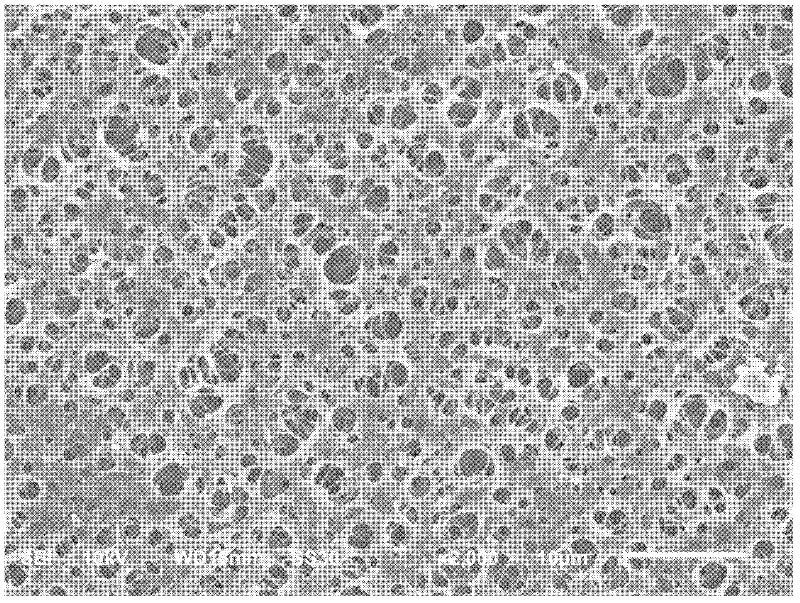Preparing process of microporous composite polymer battery separator
A technology of composite polymer and battery diaphragm, applied in the direction of battery components, circuits, electrical components, etc., can solve the problems of poor ionic conductivity, unfavorable ionic conductivity, poor lithium compatibility, etc., and achieve high production efficiency and ionic conductivity Good, the effect of improving the service life and performance
- Summary
- Abstract
- Description
- Claims
- Application Information
AI Technical Summary
Problems solved by technology
Method used
Image
Examples
Embodiment 1
[0047] Step 1, prepare PMMA:
[0048] In inert gas N 2 Under atmosphere protection, add 1 to 3 parts by weight of emulsifier into 60 to 67 parts by weight of deionized water and stir to dissolve, then add 30 to 37 parts by weight of monomer n-methyl methacrylate, At the same time, the temperature is raised to 55-65°C, and after reacting for 0.5-2 hours, 0.1-0.4 parts by weight of the initiator is added, the initiator is dissolved in other deionized water in advance, and the reaction is stirred for 6-9 hours to obtain Milky white emulsion, said milky white emulsion is poured into the Al that is 2~5 parts by weight 2 (SO 4 ) 3 stirring in an aqueous solution to break the emulsion, and then washing with water to obtain a white polymer, and drying the white polymer under vacuum at 45-60°C to obtain PMMA;
[0049] Step 2, preparation of gel polymer solution:
[0050] (1) Add 6 g of PMMA obtained in step 1 to 1200 g of acetone solvent, heat and stir until boiling and continue b...
Embodiment 2
[0057] Step 1, prepare PMMA:
[0058] In inert gas N 2 Under atmosphere protection, add 1 to 3 parts by weight of emulsifier into 60 to 67 parts by weight of deionized water and stir to dissolve, then add 30 to 37 parts by weight of monomer n-methyl methacrylate, At the same time, the temperature is raised to 55-65°C, and after reacting for 0.5-2 hours, 0.1-0.4 parts by weight of the initiator is added, the initiator is dissolved in other deionized water in advance, and the reaction is stirred for 6-9 hours to obtain Milky white emulsion, said milky white emulsion is poured into the Al that is 2~5 parts by weight 2 (SO 4 ) 3 stirring in an aqueous solution to break the emulsion, and then washing with water to obtain a white polymer, and drying the white polymer under vacuum at 45-60°C to obtain PMMA;
[0059] Step 2, preparation of gel polymer solution:
[0060] (1) Add 6 g of PMMA obtained in step 1 to 1200 g of acetone solvent, heat and stir until boiling and continue b...
Embodiment 3
[0067] Step 1, prepare PMMA:
[0068] In inert gas N 2 Under atmosphere protection, add 1 to 3 parts by weight of emulsifier into 60 to 67 parts by weight of deionized water and stir to dissolve, then add 30 to 37 parts by weight of monomer n-methyl methacrylate, At the same time, the temperature is raised to 55-65°C, and after reacting for 0.5-2 hours, 0.1-0.4 parts by weight of the initiator is added, the initiator is dissolved in other deionized water in advance, and the reaction is stirred for 6-9 hours to obtain Milky white emulsion, said milky white emulsion is poured into the Al that is 2~5 parts by weight 2 (SO 4 ) 3 stirring in an aqueous solution to break the emulsion, and then washing with water to obtain a white polymer, and drying the white polymer under vacuum at 45-60°C to obtain PMMA;
[0069] Step 2, preparation of gel polymer solution:
[0070] (1) Add 6 g of PMMA obtained in step 1 to 1200 g of acetone solvent, heat and stir until boiling and continue b...
PUM
 Login to View More
Login to View More Abstract
Description
Claims
Application Information
 Login to View More
Login to View More - Generate Ideas
- Intellectual Property
- Life Sciences
- Materials
- Tech Scout
- Unparalleled Data Quality
- Higher Quality Content
- 60% Fewer Hallucinations
Browse by: Latest US Patents, China's latest patents, Technical Efficacy Thesaurus, Application Domain, Technology Topic, Popular Technical Reports.
© 2025 PatSnap. All rights reserved.Legal|Privacy policy|Modern Slavery Act Transparency Statement|Sitemap|About US| Contact US: help@patsnap.com



